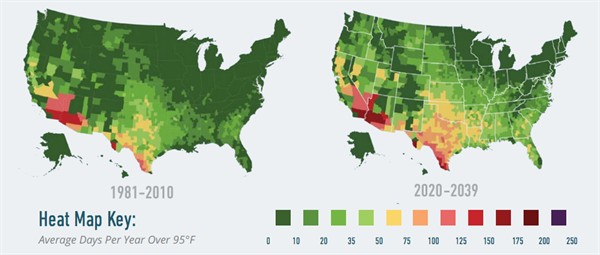Carbon Brief Staff
24.06.2014 | 1:25pmFrom coastal properties slipping into the sea to diminishing corn yields, new analysis suggests climate change could cost the US hundreds of billions of dollars if policymakers fail to take action.
The report, by the Risky Business Project, backed by dozens of prominent industry leaders, warns that the US faces “profound risks” from climate change.
With its cross-party backers and focus on economic risks, the report aims to help transform climate change from a politically divisive issue into a business case for action.
New normal
The research says two impacts of climate change put US’s economy at most risk: extreme heat and sea-level rise.
The world should expect more intense heatwaves, rainfall, and droughts as emissions increase and global temperatures rise, according to the Intergovernmental Panel on Climate Change (IPCC). Models show sea level is likely to rise by between 29 and 82 centimeters by the end of the century, and that hurricanes will become more common in some regions.
Under these conditions, the Risky Business report says the US should expect extreme weather events to become more frequent. The chart below illustrates how climate change has shifted the range of what people can come to expect from the weather:
Regional impacts
Some regions and populations are likely to feel the impacts of climate change more acutely than others, the IPCC says. Risky Business examines how these uneven effects will play out across the US.
For some, it will mean more hot days. The southwest, southeast, and upper mideast can expect an increase in the number and intensity of hot day than other parts of the country, as this map shows:
Source: Adapted by Carbon Brief from the Risky Business report
That means an average American may experience 27 to 50 days each year where the temperature is above 95 degrees fahrenheit (35 degrees celsius).
Labour productivity – the amount of goods produced or services provided in an hour’s work – could reduce by three per cent as a consequence, the report estimates, potentially costing the economy billions. Heat has health implications, too. People who must work outside, or those who don’t have access to air conditioning, face “severe health risks” under these conditions, it says.
While heat may be a problem out west, businesses on the east coast should be more worried about rising sea levels, the report continues. $238 to $501 billion of coastal property could be below sea level by 2100 if the US’s emissions continue in line with current trends, it estimates.
In the middle of the country, the picture is less clear. While warmer temperatures could benefit farmers in the north of the Great Plains region, those gains are likely to be offset by losses in the Midwest and South, the report’s analysis shows.
And overall, corn, soy, wheat and cotton production are likely to decline by 14 per cent by 2050, and 42 per cent by 2100, it estimates.
But while climate change’s total economic threat runs into hundreds of billions of dollars, the report emphasises that it’s it’s not too late to act.
It urges policymakers to make funding projects to help the US become more resilient, such as building better sea defences, a priority. At the same time, it calls on companies to incorporate climate change threats onto their balance sheets and US policymakers to engage with international efforts to tackle climate change.
Many of the climate change’s worst impacts could be averted if the US takes immediate action to curb emissions, the report notes. This could turn out to be the most risk-averse strategy of all.
Risky language
By framing climate change as a business risk, the report is intended to speak the private sector’s language.
James Painter at the Reuters Institute for the Study of Journalism writes in his book, ‘Climate Change in the Media: Reporting Risk and Uncertainty’, that risk framing echoes existing business practice:
“It is not just the insurance sector where risk assessment is embedded. It is also an essential part of the way most companies make decisions about the future. Indeed, some authors maintain it has been at the heart of economic progress.”
An op ed in the Washington Post by the the report’s co-chairs neatly taps into this culture of risk management:
“If the United States were run like a business, its board of directors would fire its financial advisers for failing to disclose the significant and material risks associated with unmitigated climate change.”
The Risky Business Project isn’t just careful about the language it uses – it also hopes to unite warring political factions. The authors of the op ed are Republican former US Treasury Secretary Henry Paulson, Republican ex-New York Mayor Michael Bloomberg – also a Republican – and Tom Steyer, a hedge-fund billionaire and major Democratic donor.
The one thing they have in common? As Paulson says in an interview with the Wall Street Journal, they all “agreed on the nature of the problem, which is that climate change is a huge economic risk.”
By outlining climate change’s threats in terms businesses can understand, the report hopes to stimulate action before risks become reality.



